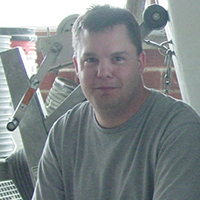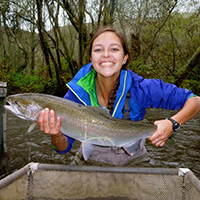 Chris Johnson (MS)
Chris Johnson (MS)
johnsclj@u.washington.edu
Chris received his BA in biology from Central Washington University in 2002, and currently works as a fisheries biologist within WDFW’s Science Division; where his research focuses on density dependence, and environmental factors potentially influencing juvenile salmon growth, abundance, and survival. Chris’ past research covers a variety of topics, including nutrient addition, impacts of entry error to data quality, and development of a standardized methodology for evaluation of salmonid egg-to-fry survival over large spatial scales. Chris is currently working to better understand parental and environmental effects to salmonid pre and post-emergence development and survival. Select publications:
- Roni, P., C. Johnson, T. De Boer, G. Pess, and D. Sear. In press. Interannaul variability in the effects of physical habitat and parentage on Chinook salmon egg-to-fry survival. Canadian Journal of Fisheries and Aquatic Sciences.
- Johnson, C. L., P. Roni, and G. R. Pess. 2012. Parental effect as a primary factor limiting egg-to-fry survival of spring Chinook salmon in the upper Yakima River Basin. Transactions of the American Fisheries Society 141(5):1295-1309.
- Johnson, C. L., G. M. Temple, T. N. Pearsons, and T. D. Webster. 2009. An evaluation of data entry error and proofing methods for fisheries data. Transactions of the American Fisheries Society 138(3):593-601.
- Johnson, C. L., P. Roni, A. Murdoch, M. Hughes, and T. De Boer. In prep. Environmental and parental influences to Spring Chinook incubation survival and development in the Chiwawa River, Washington State.
mcelroyk@u.washington.edu
Katie received her B.S. in Marine Biology from the University of California, Santa Cruz in 2014. She continued her education at UCSC and received her Master’s in Ecology and Evolutionary Biology in 2016. During her Master’s, she studied juvenile Chinook salmon habitat use on the San Joaquin River. She worked with Cramer Fish Sciences to advise the San Joaquin River Restoration Program on strategies for habitat restoration. After falling in love with Alaska during a summer working as an aquarist intern at the Alaska SeaLife Center, she decided to join the Alaska Salmon Program at UW. She is broadly interested in the interfaces of ecology and evolution and fisheries management and conservation. She plans to explore how selective forces interact with each other and the environment to influence sockeye salmon population dynamics and ecology in Bristol Bay, Alaska.
Co-supervised by Tom Quinn and Ray Hilborn.
